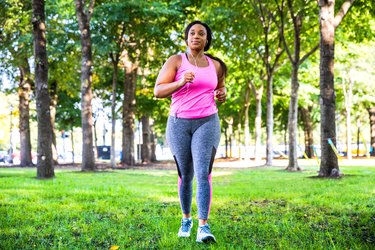
Many people enjoy going on walks around their neighborhood, city or local park. And it pays to kick it up a notch. Brisk walking is not only an enjoyable pastime, it also has several health benefits. Keep reading to learn how brisk walks can improve your wellbeing and how far and often you should aim to walk.
Tip
Brisk walking is defined as 100 steps per minute or 3.5 miles/hour on a treadmill and can benefit your physical, mental and emotional health. For best results, aim to walk for 30 minutes a day and track your steps to motivate yourself.
Video of the Day
Benefits of Brisk Walking
Brisk walking has several physical health benefits. The American Heart Association says that 150 minutes per week of moderate exercise can help improve overall cardiovascular health. Aerobic exercises, such as brisk walking, are beneficial to your heart health. Moderate activity can also help lower blood pressure and cholesterol.
Video of the Day
Being fit enough to walk briskly also bodes well for your lifespan. In a September 2014 study published by the Journal of General Internal Medicine, researchers studied a group of older adults. They discovered that being fit enough to walk briskly (100 or more steps per minute) could serve as a predictor of reduced mortality.
The benefits of brisk walking aren't just physical, either — walking can help you mentally and emotionally as well. An October 2017 study published in PeerJ looked at the benefits of exercise such as brisk walking in healthy older adults. Adults who went on regular brisk walks performed cognitive tasks better than adults who did not walk regularly.
If you walk outside, brisk walks can even have an emotional benefit. According to a March 2014 study published in the Journal of Rehabilitation Medicine, a nature-based rehabilitation program for patients with depression or reactions to severe stress could be beneficial by resulting in reduced healthcare consumption. Nature is a natural de-stresser, so brisk walks outside might help lower your stress.
Walk 30 Minutes a Day
What's the best way to incorporate a walk into your day and reap all these benefits? If you have a dog, you probably already go on regular walks. If not, try to make walking a part of your daily routine, either solo or with a workout buddy.
Walk to work if you're able to. If it's too far away or not safe, Harvard Health Publishing recommends walking to the train station or parking a few blocks away from your office. You can also take a brisk walk on your lunch break — you'll likely find that when you sit down at your desk again, your mind is clear and it's easier to get the work done.
However you can, try to get in 30 minutes of walking a day — whether that's one long walk or whether you split the time up into two smaller ones.
The distance you cover in 30 minutes depends on your personal fitness level. You might be able to walk one to two miles in half an hour, but if you can't, don't sweat it. To motivate yourself, track your steps using a smartphone, or simply try to walk a certain number of blocks every day. If you make a habit of walking regularly, you will likely find your endurance and speed increasing before long.
To make sure your walk qualifies as a brisk walk instead of just a leisurely stroll, focus on your form. Take purposeful strides and look straight ahead. Use arm motions, too, lightly swinging your arms back and forth. Check your breathing to tell whether you're walking briskly: If you can speak but can't sing, you're on a brisk walk.
- NCBI: Walking Cadence and Mortality Among Community-Dwelling Older Adults
- NCBI: The Benefits of Tai Chi and Walking For Cognitive Function and Fitness In Older Adults
- NCBI: Nature-Assisted Rehabilitation for Reactions to Severe Stress And/Or Depression
- Harvard Health Publishing: Walking: Your Steps to Health
- American Heart Association: Recommendations for Physical Activity in Adults
Was this article helpful?
150 Characters Max
0/150
Thank you for sharing!
Thank you for your feedback!